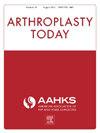Association Between Lithium Use and Periprosthetic Fracture After Total Hip Arthroplasty
IF 2.1
Q3 ORTHOPEDICS
引用次数: 0
Abstract
Background
Periprosthetic fracture (PPFx) is a devastating complication following total hip arthroplasty (THA), with concern for higher risk in osteoporotic patients. Lithium is associated with higher bone mineral density, and has emerged as a potential low-cost, widely available method for preventing fractures, promoting fracture healing, and improving implant osseointegration. This study investigated the association between lithium use and risk of PPFx following THA.
Methods
Retrospective review of the PearlDiver Mariner Patient Claims Database was performed, querying all patients who underwent THA for osteoarthritis from 2010 to 2022. Lithium-use patients were those who filled lithium prescriptions for at least 90 days before and 90 days after THA. These patients were propensity-score matched to controls not on lithium in a 1:4 ratio, matching for age, diagnosis of bipolar disorder, gender, body mass index, Charlson Comorbidity Index, and insurance. PPFx rate was compared between groups at 90 days and 2 years postoperatively. Secondarily, rate of aseptic loosening, revision, and prosthetic joint infection were compared between groups.
Results
Four thousand six hundred seventy patients were included, with 934 patients on lithium and 3736 controls. There was no difference in PPFx rate (90 day: lithium 1.3% vs no lithium 1.2%, P = .97; 2 year: lithium 1.7% vs no lithium 1.9%, P = .93), aseptic loosening, revision, or prosthetic joint infection.
Conclusions
Despite the theoretical benefit of lithium on bone density, it was not associated with a difference in the rate of PPFx or other surgical complication following THA. Further work is needed to address treatment of osteoporosis and prevention of periprosthetic fracture in the arthroplasty population.
全髋关节置换术后使用锂与假体周围骨折的关系
背景:假体周围骨折(PPFx)是全髋关节置换术(THA)后的一种破坏性并发症,骨质疏松患者的风险更高。锂与较高的骨密度有关,已成为一种潜在的低成本、广泛可用的预防骨折、促进骨折愈合和改善种植体骨整合的方法。本研究调查了全髋关节置换术后使用锂与PPFx风险之间的关系。方法对PearlDiver Mariner患者索赔数据库进行回顾性分析,查询2010年至2022年期间因骨关节炎接受THA治疗的所有患者。使用锂的患者是那些在THA之前和之后至少90天服用锂处方的患者。这些患者的倾向评分与未服用锂的对照组按1:4的比例匹配,与年龄、双相情感障碍诊断、性别、体重指数、Charlson合并症指数和保险相匹配。比较两组术后90天和2年PPFx率。其次,比较两组间无菌性松动、翻修和假体关节感染的发生率。结果纳入4670例患者,其中锂治疗组934例,对照组3736例。PPFx率(90天:锂1.3% vs无锂1.2%,P = 0.97; 2年:锂1.7% vs无锂1.9%,P = 0.93)、无菌性松动、翻修或假体关节感染均无差异。结论:尽管理论上锂对骨密度有好处,但它与全髋关节置换术后PPFx或其他手术并发症的发生率差异无关。在关节置换术人群中,骨质疏松症的治疗和假体周围骨折的预防需要进一步的研究。
本文章由计算机程序翻译,如有差异,请以英文原文为准。
求助全文
约1分钟内获得全文
求助全文
来源期刊

Arthroplasty Today
Medicine-Surgery
CiteScore
2.90
自引率
0.00%
发文量
258
审稿时长
40 weeks
期刊介绍:
Arthroplasty Today is a companion journal to the Journal of Arthroplasty. The journal Arthroplasty Today brings together the clinical and scientific foundations for joint replacement of the hip and knee in an open-access, online format. Arthroplasty Today solicits manuscripts of the highest quality from all areas of scientific endeavor that relate to joint replacement or the treatment of its complications, including those dealing with patient outcomes, economic and policy issues, prosthetic design, biomechanics, biomaterials, and biologic response to arthroplasty. The journal focuses on case reports. It is the purpose of Arthroplasty Today to present material to practicing orthopaedic surgeons that will keep them abreast of developments in the field, prove useful in the care of patients, and aid in understanding the scientific foundation of this subspecialty area of joint replacement. The international members of the Editorial Board provide a worldwide perspective for the journal''s area of interest. Their participation ensures that each issue of Arthroplasty Today provides the reader with timely, peer-reviewed articles of the highest quality.
 求助内容:
求助内容: 应助结果提醒方式:
应助结果提醒方式:


